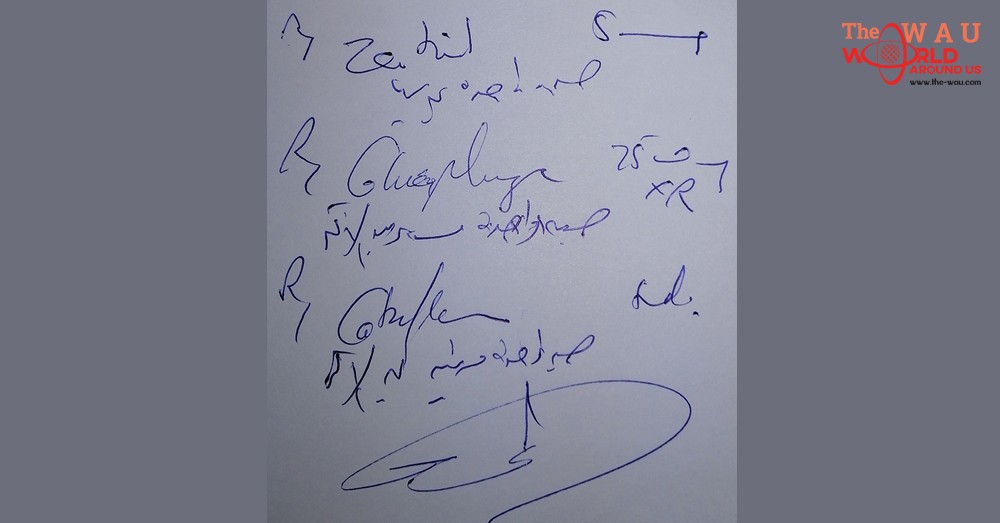Have you ever wondered how a small paper that is written in an incomprehensible language can have meaning and may make a patient happy or in misery. The doctor’s scribbles written on the prescription is similar to the scribble or code used during wars and only can be understood by Doctors and Pharmacists.
Perhaps the development of modern drugs makes the issue of dispensing medicines more important for the pharmacist, who must be vigilant when reading the prescription and examine every one very carefully so as not to fall in error caused by the unclarity of the doctor’s handwriting, therefore, the pharmacist should not prepare nor dispense the medicines before comprehending and knowing for sure what the doctor has written accurately.
The prescription is a written document from the doctor to the pharmacist to prepare and dispense a specific medicine with reference to the method of use, a document that only the doctor has the right to write, which is a great responsibility shouldered upon the pharmacist.
It is assumed that the doctor is serious and alert when writing the prescription because indifference or wrong writing can lead to difficulties and delay in the preparation and disposal of the medicines and in certain cases can lead to unfortunate incidents. Those with experience in this field believe that this small paper can be a cause for joy of three people; the patient, the pharmacist and the doctor, and it may be a cause of tragedy if read incorrectly.
Except
In this regard, Dr Ihab Abdul Ghani, preventive health doctor at the Ministry of Health, told KUNA that dispensing of prescriptions is done electronically in the Ministry’s centers, except in the case of a breakdown of the computer system, then, the prescription is written manually.
He said that the reason behind the lack of clarity of the content of the prescription is attributed to lack of sufficient time for the physician and the large number of patients, a matter that requires speed in writing, stressing that it is an understandable language for the pharmacist. He explained that the current electronic prescriptions may increase this problem when having to write the prescription manually, and may cause the handwriting to be even worse due to the lack of use of pen in writing and keep relying on the computer.
He said that sometimes the doctor writes a prescription which may be incomprehensible for a colleague but understood by the pharmacist because of the large number of prescriptions being dealt with daily and because of the pharmacist’s professionalism in this field. On the other hand, Head of the specialist pharmacists Essam Al-Sultan said in a similar statement to KUNA that pharmacists, based on their experience, know the names of drugs and doses and duration of treatment and connect drugs to each other according to the diagnosis, in addition to the patient-pharmacist conversation which all together give the pharmacist a clear evidence of the type of drug needed, thus, “decoding the code”.
Al-Sultan added that writing the prescription is hardly a universal language, but the difference here is how it is written. Asked how to act if the pharmacist did not understand the doctor’s prescription, Al-Sultan replied that the pharmacist should return the prescription to the doctor for modification or clarification or contact the doctor directly. Asked about the margin of possible error in reading the prescription, he stressed that the margin of error dwindles with the more years the pharmacist has of experience, pointing out that careful reading of the prescription, caution and following the rules of medicines disposal can reduce the margin of error.
He added that the electronic prescriptions have made it easy for the pharmacists to read and comprehend what’s written on them, thus making the process very easy and efficient. Dr Fatima Al-Saffar, a pharmacist, said that each doctor in the private sector has his own stamp showing his specialty and the quality of the drugs that can be prescribed to the patient, and with dealing for a long time with these prescriptions, the pharmacist becomes acquainted with the doctor’s handwriting and can detect the name of the medicine from the first letter written by the doctor.
She added that when the doctor’s handwriting is never clear, the pharmacist should contact the doctor to know for sure the name of the drug, recollecting some doctors who took care of their handwriting when writing the medical prescription in a nice line to make it easy for the pharmacist to read.
Published
A recent study published on the Lifestyle website in the United States on why doctors write this way, some analysts attributed this to the large number of prescriptions doctors write per day, as a statistic indicates that the doctor signs within 8 hours of work 50-100 prescriptions, in addition to having to document all reports of cases and patients who supervise them.
Other analysts say that physicians’ writing is not directed at the public to read, and only doctors like them understand what their colleagues write and the symbols and abbreviations they use. Furthermore, tension, excessive work and thinking often make the doctor uninterested in what he writes because his vision of things changes through study and discovery of the human body, and there are things much more important than his handwriting.
The study also revealed several reasons, including the narrowness and size of the paper besides the huge number of patients a matter that forces the doctor to quickly scribble on the prescription knowing that his handwriting is for sure understood by the pharmacist. Another reason was attributed to the doctors’ understanding that their handwriting will be stored in files and will not be viewed again. A report issued by the Medical Institute in Washington revealed that the doctors’ bad handwriting cause the deaths of nearly 7,000 patients around the world every year. After all, the fate of a patient is subject to how well the pharmacist comprehends the doctor’s prescription.
Share This Post















